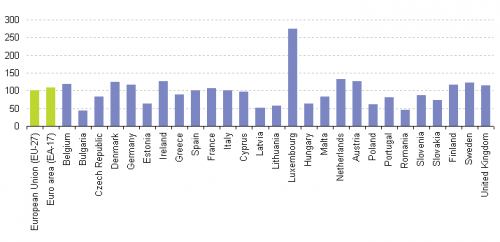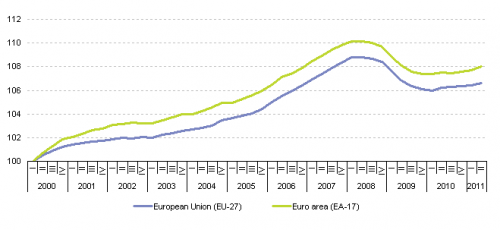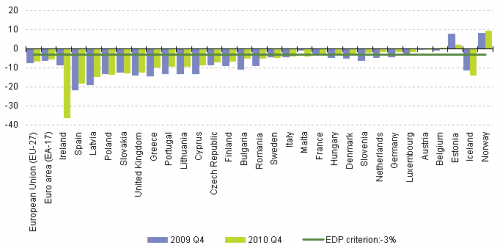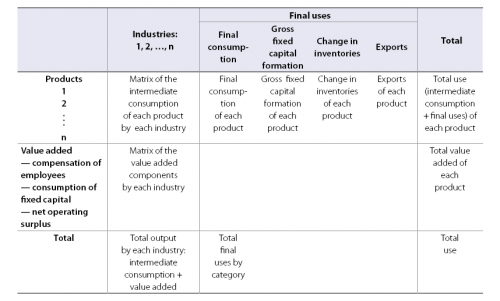National accounts - an overview
Data and text (largely) from October 2011 and on the
basis of ESA 95, which has been replaced by ESA 2010.
National accounts are a system of accounts and balance sheets that provide a broad and integrated framework to describe an economy, whether a region, a country, or a group of countries such as the European Union (EU). For internationally comparable national accounts this system needs to be based on common concepts, definitions, classifications and accounting rules, in order to arrive at a consistent, reliable and comparable quantitative description of an economy. National accounts provide systematic and detailed economic data useful for economic analysis to support the development and monitoring of policy-making. This article provides a brief description of various types of accounts in the EU.
Full article
General features of national accounts
National accounts record economic activities in a systematic manner, distinguishing actors belonging to institutional sectors such as households, corporations and government. The system describes the various transactions or other changes in assets (flows) during a period of time as well as the level (normally at the end of a period of time) of stocks.
A particular focus on the monitoring of fiscal policies in the EU is reflected through the development of government finance statistics. The recent financial and economic crisis has also underlined the importance of financial accounts, which present financial transactions, other changes in financial assets or liabilities, and financial balance sheets.
Furthermore, national accounts serve as the foundation of a broader statistical system. This is the case for social and economic statistics in general, and for satellite accounts in particular.
The European system of national and regional accounts known by the abbreviation ESA is fully consistent with the worldwide guidelines on national accounting, namely the system of national accounts (SNA): the SNA is published jointly by the United Nations, the Commission of the European Communities, the International Monetary Fund (IMF), the Organisation for Economic Co-operation and Development (OECD) and the World Bank.
The ESA is not restricted to annual national accounting, but applies also to quarterly accounts and regional accounts. The ESA consists of two main sets of tables, namely the input-output framework/accounts by industry and the sector accounts. The ESA also encompasses concepts of population and employment that are relevant for both the sector accounts and the input-output framework.
National accounts are compiled separately by each EU Member State, more specifically by the national statistical office or another institution appointed by the government, for example, the national central bank. The accounts are the result of a process of integration of data from many sources, for example, statistical surveys of businesses and households and administrative data. European national accounts are compiled by Eurostat by combining Member States’ national accounts. For this purpose countries are required to provide Eurostat with a pre-specified data set according to a fixed transmission timetable.
Annual accounts
Annual data constitute the core of the national accounts system, both regarding their level of detail and their use for the estimation of quarterly data (see next section). Data within the national accounts domain encompasses information on the gross domestic product (GDP) and its components, final consumption aggregates, income, savings and employment. Breakdowns exist for certain variables by economic activity (as defined by the activity classification NACE), investment products, final consumption purpose and institutional sectors.

Figure 1 provides an example of one of the most common analysis of data from national accounts. The analysis of GDP across countries is facilitated by studying GDP per capita, so removing the influence of the absolute size of the population. GDP per capita is often considered as a broad economic indicator of living standards, despite the fact that this is not the main purpose of such an indicator. An index of GDP per capita in relation to the EU average (set to equal 100) can be derived: if the index of a country is higher/lower than 100, this country’s level of GDP per head is above/below the EU-27 average. Such comparisons of the economic activity of countries should ideally be made using a series that reflects the purchasing power of each currency, rather than using market Exchange rates, and as a result this indicator is generally expressed in purchasing power standards (PPS).
Quarterly accounts
The motivation for quarterly accounts stems from some of the shortcomings of annual data that make them unsuitable for the purpose of supporting short-term economic analysis, for example:
- ongoing economic policy decisions, which require prompt information on economic developments are inadequately supported, especially for the current year;
- business cycle fluctuations are not adequately captured because the average period of the cycle does not generally coincide with calendar years;
- there is a long delay after the end of the reference period before the figures are published.
Quarterly accounts have the advantage of being able to provide a coherent set of indicators on both non-financial and financial economic activity that are available with a short time lag. They have thus been developed to form an integral part of the system of accounts. A chapter on quarterly national accounts was introduced in the 1995 version of the ESA and Eurostat published a separate manual, a ‘Handbook on quarterly accounts’ in 1999. This aims to ensure that quarterly accounts adopt the same principles, definitions and structure as the annual accounts, subject to certain modifications, due to the period of time covered.
However, quarterly data follow a simplified scheme because the purpose of quarterly accounts is to track movements in key macro-economic aggregates, not to provide the same structural detail of the economy as the annual accounts, and to aid rapid compilation, recognising that there are less source data available quarterly.
Some further particularities of the quarterly accounts include the treatment of seasonality, and ensuring consistency between quarterly and annual accounts.
The statistical methods used for compiling quarterly accounts may also differ quite considerably from those used for the annual accounts. They can be classified in two major categories: those based on the availability at quarterly intervals, with appropriate simplifications, of similar sources to those used to compile the annual accounts; and indirect procedures based on time disaggregation of the annual accounts data in accordance with mathematical or statistical methods relying on appropriate quarterly indicators. In some systems, the annual accounts are a by-product of the quarterly system and there is no separate annual calculation.
The increasing role that the quarterly accounts have assumed in recent years demonstrates their importance for short-term economic analysis and justifies the increasing efforts devoted to compiling them. As all Member States compile quarterly accounts, EU and euro area aggregates are, in principle, obtained through the aggregation of the data from the Member States. Eurostat regularly estimates the quarterly EU accounts from annual EU accounts using quarterly information that is available from the Member States.
The main reason for this approach is the strong demand for timely quarterly accounts, as business cycle analysis requires quarterly results for the EU and in particular the euro area much earlier than the arrival of data for the last of Member States.
Eurostat publishes GDP flash estimates about 45 days after the end of each quarter and more detailed breakdowns after 65 days and 105 days. Quarterly estimations of employment figures are released after 75 days and 105 days and quarterly sector accounts after 120 days.
Employment
Employment and population have traditionally been considered auxiliary variables in national accounts, intended to calculate ratios per inhabitant or per employed person. The importance of employment within the system has increased, and is now considered as a key short-term economic indicator. Employment in national accounts is the result of the integration of data from many sources, and should be estimated simultaneously to and consistently with other national accounts variables, like output and the compensation of employees. However, it should be kept in mind that employment figures in national accounts may differ from those produced by labour market statistics, such as the Labour force survey (LFS), which also provides data on employment and unemployment, broken down by gender or other characteristics of the individual. The ESA distinguishes resident persons in employment (the national scope) from employment in resident production units (the domestic scope): the difference is significant for geographical areas with large cross-border flows of persons employed. Notably the LFS focuses on resident households, and so is closer to the national scope definition in the ESA, but there are also other differences between the ESA and LFS employment data.

Figure 2 presents the evolution of employment in the EU-27 and the euro area –consistent with the ESA95 national accounts concepts. Using seasonally adjusted data, the figure illustrates that the number of persons employed progressively accelerated over the past decade until the economic and financial crisis provoked a setback in European labour markets from mid-2008.
Supply, use and input-output tables
The supply and use framework is the part of the national accounts system which focuses on the production and use of goods and services in an economy. It reflects the activities of industries in which intermediate products and primary inputs (such as labour and capital) are required. Supply and use tables show where and how goods and services are produced and to which intermediate or final use they flow.
The input-output framework consists of three types of tables: supply and use tables, symmetric input-output tables and tables linking the supply and use tables to the sector accounts; these are an integral part of the ESA. Compilation issues and harmonised solutions are presented in the Eurostat manual of supply, use and input-output tables.
These tables describe the production process (such as the cost structure and the generation of income) by industry or activity and the use of goods and services (output, imports, exports, final consumption, intermediate consumption and capital formation by product group). Within the national accounts system the supply, use and input-output tables offer the most detailed portrait of an economy’s production and use activities and also provide a consistent framework for balancing national accounts.
These tables show among others:
- the structure of the costs of production and the value added, which is generated in the production process;
- the interdependencies of industries;
- the flows of goods and services produced and used within the national economy;
- international trade in goods and services with the rest of the world.
- Supply tables record how products are made available in an economy: this may be output from a range of domestic industries or imports.
In a similar manner the use of the same list of products can be analysed differentiating the use for intermediate consumption of domestic industries or final uses such as final consumption, fixed capital formation or exports. Use tables also show the components of value added (such as compensation for employees or consumption of fixed capital) by industry.
The framework must fulfil two identities. The output of each industry is equal to the sum of intermediate consumption plus value added. For each product, total supply (output plus imports) equals the sum of intermediate consumption, final consumption, gross capital formation and exports.
A symmetric input-output table is a product- by-product (or industry-by-industry) matrix: it rearranges both supply and use in a single table with a single, identical product (or industry) classification applied for both rows and columns.
Sector accounts
Sector accounts provide, by institutional sector, a systematic description of the different stages of the economic process, from production through to the use of income and financial and non-financial accumulation. The sector accounts also include balance sheets to describe the stocks of assets, liabilities and net worth.
The European Central Bank (ECB) and Eurostat publish quarterly EU and euro area accounts by institutional sector, and recently key indicators for Member States have also been published. Macro-economic developments, such as economic growth and inflation, are driven by the actions of the individual economic subjects in an economy. The institutional sectors combine institutional units with broadly similar characteristics and behaviour: households and non-profit institutions serving households (NPISH), non-financial corporations, financial corporations, and government. Grouping economic subjects with similar behaviour into institutional sectors helps to understand the functioning of the economy.
Transactions with non-residents and the financial claims of residents on non-residents, or vice versa, are recorded in a separate account referred to as the rest of the world.
Figure 3 presents the shares of institutional sectors in key national accounts aggregates.

The households sector comprises all households and household firms, such as sole proprietorships and most partnerships that do not have an independent legal status. Therefore, the households sector, in addition to consumption, also generates output and entrepreneurial income.
For presentational reasons, non-profit institutions serving households (NPISH), such as charities and trade unions, are grouped in the European accounts with households; their economic weight is relatively limited. The non-financial corporations sector comprises all private and public corporate enterprises that produce goods or provide non-financial services to the market. Accordingly, the government sector excludes non-market public enterprises and comprises central, state (regional) and local government and social security funds. The financial corporations sector comprises all private and public entities engaged in financial intermediation, such as monetary financial institutions (predominantly banks), investment funds, insurance corporations and pension funds.
Government finance statistics
Government finance statistics (GFS) present the economic activities of government in a harmonised and comparable way. GFS may differ noticeably from nationally-specific budget or public accounting presentations as far as the scope of units and the recording of transactions are concerned. The GFS present revenue, expenditure and deficit, as well as transactions in assets, liabilities, other economic flows, and balance sheets. They are fully consistent with the general government sector within the national accounts, but have an alternative (integrated) presentation for users.

The GFS attract particular attention as they form the basis for fiscal monitoring in Europe, notably statistics related to the excessive deficit procedure (EDP).
The EDP is defined by Article 104 of the Treaty on European Union (the so-called Maastricht Treaty), which foresaw the creation of the euro. The Treaty obliges Member States to comply with budgetary discipline by adhering to two criteria: a deficit to GDP ratio and a debt to GDP ratio not exceeding reference values of 3 % and 60 % respectively, as defined in the Protocol on the EDP annexed to the Treaty; these reference values are based on GFS (national accounts) concepts. Under ESA 2010, the government deficit is the net lending/net borrowing of government as defined in the ESA. Government debt is defined as the total consolidated gross debt at nominal (face) value in the following categories of government liabilities: currency and deposits, debt securities and loans.
The Manual on government debt and deficit (MGDD) provides interpretation and guidance to establish agreed methodological practices for the measurement of government deficit and debt.
The European Commission is responsible for providing the data used for the EDP, and within the European Commission this task is undertaken by Eurostat on the basis of EDP statistics provided by the Member States.
Financial accounts
Within the ESA, financial accounts show financial transactions, holding gains and losses, other changes in financial assets or liabilities, and the financial balance sheets. The compilation of these accounts is the subject of a manual on sources and methods for the compilation of ESA95 financial accounts. Most transactions involving the transfer of ownership of goods or assets or the provision of services have some counterpart entry in the financial account. The counterpart may take the form of a change in currency or transferable deposits, an account receivable or payable (for example, a trade credit) or some other type of financial asset or liability.
Moreover, there are many transactions that are recorded entirely within the financial account, where one financial asset is exchanged for another or a liability is repaid with an asset. Such transactions change the distribution of the portfolio of financial assets and liabilities and may change their total amounts but do not affect net lending/net borrowing.
Accounts on financial transactions show how the surplus or deficit on the capital account is financed by transactions in financial assets and liabilities. Thus, the value of the balance of the financial account (net acquisition of financial assets less net incurrence of liabilities) is equal, in theory, to net lending/net borrowing, the balancing item of the capital account.
The financial account indicates how net borrowing sectors obtain resources by incurring liabilities or reducing assets, and how net lending sectors allocate their surpluses by acquiring assets or reducing liabilities. The account also shows the contributions to these transactions of the various types of financial assets, and the role of financial intermediaries.
In addition, accounts on nominal holding gains/losses show the gains/losses on a given quantity of an asset/liability as the change in value for the owner of that asset/liability as a result of change in prices or Exchange rates. Any changes in financial assets and liabilities that are not due to financial transactions, holding gains and losses or reclassifications are recorded as other changes in volume, for example, write-offs of bad debt.
Financial balance sheets are statements of the value of assets and liabilities at a particular point in time: the balancing item is net worth or, in the case of the whole economy, national wealth – the aggregate of non-financial assets and net claims on the rest of the world. Financial accounts form an important tool for analysing financial flows taking place between well-defined institutional sectors within the economy, and between those institutional sectors and the rest of the world, and for assessing financial interrelationships within the economy and vis-a-vis the rest of the world at a particular point in time. Because of their link with the capital and use of income accounts, financial accounts serve as an important instrument to monitor the transmission process of monetary policy. The completeness of financial accounts makes possible the analysis of monetary aggregates as well as the analysis of longer-term financial investments and sources of finance. Consequently, the financial accounts provide a way of examining the financial effects of economic policy and assistance for decisions regarding future policy. They can be used to investigate factors influencing the holdings of and transactions in, different types of financial instruments, for example, changes in interest rates. For financial institutions the financial account shows the large amounts of funds which are channelled through them as financial intermediaries. The scale of this makes it important to be aware of changes in their sources of funds and in their use of those funds. The transactions of financial institutions reflect the liquidity, current and capital expenditure of other sectors, and the financing of the government sector net cash requirement.
The financial balance sheets show the financial worth of each sector of the economy at a particular point in time. The changes from previous balance sheets illustrate both the change in the valuation of different instruments (for example, as stock markets move or currency Exchange rates change) and the changing portfolios resulting from the financial transactions of the sectors. This allows the measurement of so-called ‘wealth effects’ through the change in the market prices of assets.
Regional economic accounts
Regional accounts are a regional specification of the corresponding accounts of the total economy. A full set of accounts at the regional level implies treating each region as a separate economic entity. In this context, transactions with other regions become external transactions. Conceptual difficulties partly explain why regional accounts are limited to recording production activities by industry and to accounts for some institutional sectors like households.
Nevertheless, regional accounts do provide information in particular on regional GDP, regional gross value added and some other indicators by industry.
As already noted for national accounts it is common to present GDP as an average per inhabitant and for regional statistics the distinction between place of work and place of residence is therefore particularly significant. Regional GDP measures the economic output achieved within regional boundaries, regardless of whether this was attributable to resident or non-resident employed persons. The analysis of GDP per inhabitant is therefore only straightforward if all employed persons involved in generating GDP are also residents of the region in question.
In areas with a high proportion of inbound commuters, regional GDP per inhabitant can be extremely high and conversely it can be relatively low in the surrounding regions. Regional GDP can be used to identify regional disparities within and between countries, as well as convergence between regions.
Satellite accounts
For some uses, the concepts in the ESA are insufficient and may need to be supplemented. One of the ways this can be done in a coherent manner is through the development of satellite accounts. Satellite accounts can show more detail where necessary, or they may enlarge the scope of the accounting system by adding non-monetary information, or they may change some basic concepts – for example, by enlarging the concept of capital formation. Generally, satellite accounts follow the basic concepts and classifications of the national accounting system, only deviating when the specific purpose of the satellite account requires a modification.
Satellite accounts may include stocks and flows which are not readily observable in monetary terms (or without a clear monetary counterpart) as these are not well served by the core national accounts system. Examples are measuring time usage for production within households, or information on the number of pupils or time spent in education, or the health of trees as an indicator of pollution. Satellite accounts offer a possibility to link such statistics in non-monetary units to national accounts by using the classifications employed in the standard framework for these non-monetary statistics.
This linkage can then facilitate the analysis of interactions between the standard national accounts information and the information in satellite accounts. One example of a satellite account where considerable development has been made within the United Nations and the EU is environmental accounts, which are a tool to analyse the links between the environment and the economy. These can be used, for example, to analyse to what extent our current production and consumption patterns are degrading natural resources, or to measure the environmental effects of economic policy measures.
Another example of satellite accounts is the tourism satellite account for which a new joint methodological framework was released in 2008 by the United Nations, Eurostat, the OECD and the World Tourism Organisation (WTO). The extent of the use of satellite accounts is growing, and these accounts are more prominently discussed in the revised SNA 08/ ESA 2010 and more more actively encouraged as alternative presentations.
Direct access to
- Annual national accounts (t_nama)
- Quarterly national accounts (t_namq)
- Annual national accounts (nama)
- Quarterly national accounts (namq)
- Supply, use and Input-output tables (naio)
- Annual national accounts (ESMS metadata file — nama_esms)
- Annual sector accounts (ESMS metadata file — nasa_esms)
- European system of accounts ESA 1995
- Eurostat-OECD methodological manual on purchasing power parities
- Handbook on price and volume measures in national accounts
- Handbook on quarterly national accounts
- Quarterly national accounts (ESMS metadata file — namq_esms)
- Quarterly sector accounts (ESMS metadata file — nasq_esms)
- Supply, use and Input-output tables (ESMS metadata file — naio_esms)

